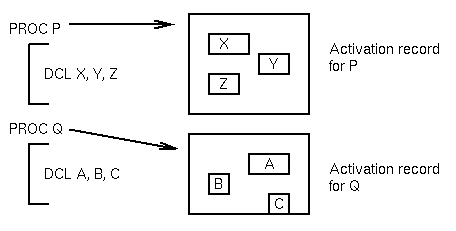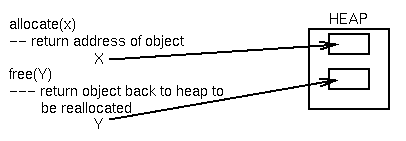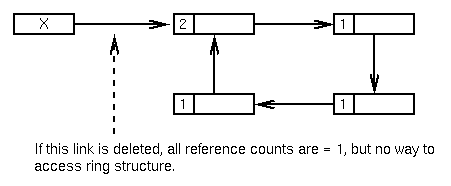
code segments for translated user programsSee Figure 5.5 in your textsystem run-time programs
temporaries in expression evaluation
input-output buffers
data structure creation and destruction operations
programmer can control over storage via some language operations: C (malloc, free), Pascal (new, dispose)most of the storage management is system-controlled
allocation: at the start of execution each piece of storage may be either allocated for some use or free.recovery: storage that has been allocated and used and that subsequently becomes available must be recovered by the storage manager for reuse.
compaction and reuse: storage recovered may be immediately ready for reuse, or compaction may be necessary to construct large blocks of free storage from small pieces.
Figure 5.5 and 5.6
Local data is stored in an area called an activation record (also called a stack frame).

Address data is a two step process:
1. Get a pointer to the relevant activation record containing the declarations.
2. Find the offset in that activation record for the data item.
IMPORTANT:
1. The activation record pointer is determined at during program execution.
It occurs frequently, so it should be an efficient calculation.
2. The offset within an activation record is fixed and determined during
compilation. It should require no - or minimal - calculations.
In functional languages, we cannot use stack-based storage for many data structures, for example, functions that are the return values of other functions. As a result, run-time data stuctures must be allocated from the heap.
A heap is a block of storage within which pieces are allocated and freed in some relatively unstructured manner.
The need for heap storage arises when a language permits storage to be allocated and freed at arbitrary points during program execution.
The heap is the major storage area for ML, LISP and Prolog is a heap. Most object-oriented languages also rely on heap allocated memory for objects.
Because it is often not clear when memory can be safely freed, such languages usually rely on an automatic mechanism for recycling memory.
There is no single heap storage management technique, but rather a collection of techniques for handling various aspects of managing this memory.

Dynamic allocation and stacks are generally incompatible.
Dangling reference (a pointer to storage that has been freed):
allocate(x);
y = x;
free(x);
==> y still points to allocated item

Garbage (inaccessible storage):
allocate(x);
allocate(x);
==> first allocation to x now lost.

Memory fragmentation:
allocate(a);
allocate(x);
allocate(y);
free(a);
allocate(z);
free(y);
allocate(b);
==> No contiguous space for b

The simplest recovery technique is that of explicit return -- when an element that has been in use becomes available for reuse, it must be explicitly identified as free and returned to the free-space list.
Many problems can result from dangling references and garbage.
First assume memory is allocateced in fixed size blocks with each block being size k.
Two simple algorithms are as follows.
Algorithm 1: Garbage collection with the two pass mark-sweep
algorithm:
1. Keep a linked list (free list) of memory blocks available to be allocated.
2. Allocate memory blocks on demand.
3. Ignore free commands.
4. When out of space, perform garbage collection:
Pass 1: Mark every memory block still allocated.
Pass 2: Every unmarked memory blocks is added to the free list of
available blocks.
The problem is how do you know if a memory block is still allocated:
Easy if regular use of pointers (Like in LISP)
Error conditions:
Algorithm 2: Reference Counts (eager method of storage reclamation)
1. Associate a reference counter field, initially 0, with every allocated
memory block.
2. Each time a pointer is set to an memory block, up the reference counter
by 1.
3. Each time a pointer no longer points to an memory block, decrease the
reference counter by 1.
4. If reference counter ever returns to 0, then free memory block.
Error conditions:
Dangling reference - Cannot occur. Reference count is 0 only when nothing
points to it.
Fragmentation - Cannot occur. All memory blocks are fixed size.
Inaccessible storage - Can still occur, but not easily. ...

Memory operations